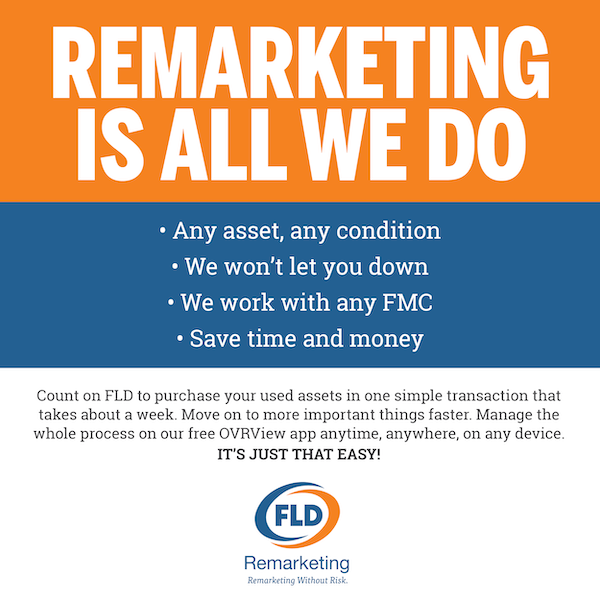
By Ed Pierce, Contributing Editor
As Market Research Manager at Motus, Ken Robinson has his finger on the pulse of the fleet industry. That includes economic considerations, and especially cost data that informs the company’s vehicle management and reimbursement solutions.
 “The Motus Platform powers a growing number of solutions for mixed-use assets — vehicles, devices and locations. In our role as a strategic partner with our customers, we aggregate a ton of cost data with very granular geographic levels,” Ken explains. “One of the ways we leverage this data is to aggregate fair and accurate reimbursement rates. We also work with corporate fleet programs, offering personal use tracking and safety solutions. We are proof that a harmonious coexistence can be maintained between company-owned and personally-owned vehicles and other assets.”
“The Motus Platform powers a growing number of solutions for mixed-use assets — vehicles, devices and locations. In our role as a strategic partner with our customers, we aggregate a ton of cost data with very granular geographic levels,” Ken explains. “One of the ways we leverage this data is to aggregate fair and accurate reimbursement rates. We also work with corporate fleet programs, offering personal use tracking and safety solutions. We are proof that a harmonious coexistence can be maintained between company-owned and personally-owned vehicles and other assets.”
“By conducting such research into trends and influencers, we are well positioned to share our insights with the industry. Because we have other lines of business that help companies wanting to empower their anywhere workforce, I write monthly reports that span into location intelligence and also mobility expense management.”
As an example of the value Motus brings to the table for fleets through its extensive research capability, Ken cites the disconnect between personal and business mileage: “Because fleet managers think of personal use as a challenging area to delve into, they may look to approximate personal use. But, that’s not always accurate, and a cost savings opportunity could be overlooked.
“We look at the industry surveys about average personal-use charge, which keep edging up steadily every year. Yet, business mileage isn’t always going up predictably every month. That is where the opportunity is to learn more about what’s happening inside of a program. This year is a good example of digging deeper because of the recovery-driven changes to field activity levels.”
Business Driving Rebounds
 In its most recent report, Motus reported that business driving activity is rebounding. Ken summarized the findings: “The business mileage activity levels across the U.S. have really accelerated back to a recovery level that has plateaued. That plateau began last summer. As we’ve navigated through the end of 2020, and into beginning of 2021, we have seen minor peaks and valleys.”
In its most recent report, Motus reported that business driving activity is rebounding. Ken summarized the findings: “The business mileage activity levels across the U.S. have really accelerated back to a recovery level that has plateaued. That plateau began last summer. As we’ve navigated through the end of 2020, and into beginning of 2021, we have seen minor peaks and valleys.”
“However, what we’re starting to see is increased activity in not only certain economic sectors, but also across the entire U.S. population. Mileage overall is starting to trend up and we expect that to continue to happen through the summer months, leading to a greater level of recovery in the second half of the year. In terms of the percentage of, say pre-pandemic versus current business mileage levels, we’re trending right around 70 to 75% recovery, depending on what point you measure from. And further recovery is what we’re starting to see.”
A Look at Industry Sectors and Geography
The Motus report cites variances in different sectors of industry. Different sectors of industry saw different 2020 recovery paces in terms of their fuel activity or business mileage. “Take food and beverage manufacturers or retail, beer, liquor distributors, grocery distribution,” Ken says. “Those businesses showed a little bit of a decline, but nothing too severe as we entered the pandemic. And really, if anything, this segment has slightly increased over the past 12 to 14 months.”
“Look at other sectors that were severely impacted. For example, suppliers to dining restaurants or distributors to educational institutions. They were impacted severely at the beginning of the pandemic. They saw a little bit of recovery by summer last summer, but still demonstrated slow growth. Now, we are seeing the level of field activity steadily increase sector-wide. Pent-up demand will fuel higher levels of activity as reopening continues in different parts of the country and also across different industries.”
From a geographic point of view, the level of business mileage activity always varies, according to Motus. Presently, business mileage is trending at about 72% of pre-pandemic levels in the Western part of the U.S. In the Northeast, it’s less — 64% of pre-pandemic mileage levels. In the South and the Midwest, the trends are around 70% of pre-pandemic business mileage.
Fuel Prices Increase Into Summer
The Motus report also addresses what’s happening with fuel. “It has been a very volatile year in terms of fuel prices,” says Ken. “If we look back at last year and think about current prices at the pumps, several factors are converging to drive fuel prices up. We think high prices will proliferate across the summer. How did this happen? Unprecedented low consumption in 2020 created a surplus of crude oil — the main driver of fuel prices. In response, a lot of the top oil producers cut production in order to raise crude prices.”
“As things return to a more normal state and consumers return to the road in large numbers, oil producers are not increasing production and supplies are not keeping up with demand. Add in the seasonality of fuel prices – gas prices naturally edge up in spring months because all the refineries switch to a summer fuel blend, and prices naturally tick up heading into the summer. Current prices were impacted by the Texas freeze in February because that caused some refineries to shut down. As long as demand keeps climbing steadily and that’s not disrupted, it’s very likely that we could see a national average approaching $3 this summer for gas.”
Residual Value and Insurance Impacts
Motus research and trend reports also addresses what’s happening with residual values, depreciation, and insurance, too. As Ken concludes, “Each of these areas we research was influenced by the pandemic, and these trends impact every fleet operation,” says Ken. “For example, a large number of people in 2020 abandoned mass transit and bought cars instead. This resulted in a shortage of new vehicles, which also increased demand for used vehicles that were already under supplied.”
“Because it’s too difficult to just instantly resupply the used vehicle space, there has been a very firm floor established under residual values. Combined with fewer than the typical mileage logged over the last year, that has really slowed depreciation and kept high trade-in values out there for vehicles. To put a number on that, used vehicle prices in March averaged 26% higher than they did a year ago. Another COVID tailwind is influencing insurance. In a year where a lot of people drove far fewer miles than usual, insurance premiums are lower for two out of every three U.S. drivers this year. That’s a pretty rare occurrence! In fact, rates haven’t gone down at that kind of scale since 2013.”
“The bad news is that, as more people return to the roads after not driving as much, there are going to be some bad habits. Those bad habits mean risk levels are also going to increase. Most likely there will be more insurance claims in 2021, inevitably driving up insurance costs. But, in the meantime, we can enjoy lower insurance rates throughout this year.”
For more information about the Motus report, contact the company at 888-312-0788 or by email: [email protected]





